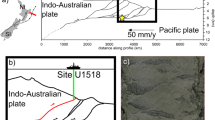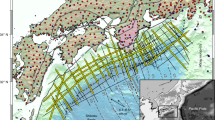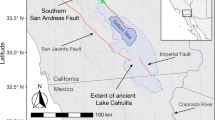Abstract
Ocean-floor carbonate- and clay-rich sediments form major inputs to subduction zones, especially at low-latitude convergent plate margins. Therefore, knowledge of their frictional behaviour is fundamental for understanding plate-boundary earthquakes. Here we report results of mechanical tests performed on simulated fault gouges prepared from ocean-floor carbonates and clays, cored during IODP drilling offshore Costa Rica. Clay-rich gouges show internal friction coefficients (that is, the slope of linearized shear stress versus normal stress data) of μint = 0.44 − 0.56, irrespective of temperature and pore-fluid pressure (Pf). By contrast, μint for the carbonate gouge strongly depends on temperature and pore-fluid pressure, with μint decreasing dramatically from 0.84 at room temperature and Pf = 20 MPa to 0.27 at T = 140 °C and Pf = 120 MPa. This effect provides a fundamental mechanism of shear localization and earthquake generation in subduction zones, and makes carbonates likely nucleation sites for plate-boundary earthquakes. Our results imply that rupture nucleation is prompted by a combination of temperature-controlled frictional instability and temperature- and pore-pressure-dependent weakening of calcareous fault gouges.
This is a preview of subscription content, access via your institution
Access options
Subscribe to this journal
Receive 12 print issues and online access
$259.00 per year
only $21.58 per issue
Buy this article
- Purchase on Springer Link
- Instant access to full article PDF
Prices may be subject to local taxes which are calculated during checkout




Similar content being viewed by others
References
Archer, D. E. An atlas of the distribution of calcium carbonate in sediments of the deep sea. Glob. Biogeochem. Cycles 10, 159–174 (1996).
Byrne, D. E., Davis, D. M. & Sykes, L. R. Loci and maximum size of thrust earthquakes and the mechanics of the shallow region of subduction zones. Tectonics 7, 833–857 (1988).
Toshiko, S., Seno, T. & Uyeda, S. A simple rheological framework for comparative subductology. Relating Geophys. Struct. Process. 76, 39–52 (1993).
Hyndman, R. D. & Wang, K. Thermal constraints on the zone of major thrust earthquake failure—the cascadia subduction zone. J. Geophys. Res. 98, 2039–2060 (1993).
Moreno, M. et al. Locking of the Chile subduction zone controlled by fluid pressure before the 2010 earthquake. Nature Geosci. 7, 292–296 (2014).
Audet, P., Bostock, M. G., Christensen, N. I. & Peacock, S. M. Seismic evidence for overpressured subducted oceanic crust and megathrust fault sealing. Nature 457, 76–78 (2009).
Ito, Y., Obara, K., Matsuzawa, T. & Maeda, T. Very low frequency earthquakes related to small asperities on the plate boundary interface at the locked to aseismic transition. J. Geophys. Res. 114, B00A13 (2009).
Brown, K. M., Tryon, M. D., DeShon, H. R., Dorman, L. M. & Schwartz, S. Y. Correlated transient fluid pulsing and seismic tremor in the Costa Rica subduction zone. Earth Planet. Sci. Lett. 238, 189–203 (2004).
DenHartog, S. A. M., Niemeijer, A. R. & Spiers, C. J. New constraints on megathrust slip stability under subduction zone P-T conditions. Earth Planet. Sci. Lett. 353, 240–252 (2012).
DenHartog, S. A. M., Peach, C. J., de Winter, D. A. M., Spiers, C. J. & Shimamoto, T. Frictional properties of megathrust fault gouges at low sliding velocities: new data on effects of normal stress and temperature. J. Struct. Geol. 38, 156–171 (2012).
Namiki, Y., Tsutsumi, A., Ujiie, K. & Kameda, J. Frictional properties of sediments entering the Costa Rica subduction zone offshore the Osa Peninsula: implications for fault slip in shallow subduction zones. Earth Planet. Space 66, 72 (2014).
Saffer, D. M. & Marone, C. Comparison of smectite- and illite-rich gouge frictional properties: application to the updip limit of the seismogenic zone along subduction megathrusts. Earth Planet. Sci. Lett. 215, 219–235 (2003).
Ikari, M. J., Niemeijer, A. R., Spiers, C. J., Kopf, A. J. & Saffer, D. M. Experimental evidence linking slip instability with seafloor lithology and topography at the Costa Rica convergent margin. Geology 41, 891–894 (2013).
Ikari, M. J., Saffer, D. M. & Marone, C. Effect of hydration state on the frictional properties of montmorillonite-based fault gouge. J. Geophys. Res. 112, B06423 (2007).
Morrow, C. A., Shi, C. & Byerlee, J. D. Strain-hardening and strength of clay-rich fault gouges. J. Geophys. Res. 87, 6771–6780 (1982).
Ranero, C. R. & von Huene, R. Subduction erosion along the Middle America convergent margin. Nature 404, 748–752 (2000).
Clift, P. & Vannucchi, P. Controls on tectonic accretion versus erosion in subduction zones: implications for the origin and recycling of the continental crust. Rev. Geophys. 42, RG2001 (2004).
Ranero, C. R. et al. A cross section of the convergent Pacific margin of Nicaragua. Tectonics 19, 335–357 (2000).
Langseth, M. G., Cann, J. R., Natland, J. H. & Hobart, M. Geothermal phenomena at the Costa-Rica Rift—background and objectives for drilling at deep-sea drilling Project Site-501, Site-504, and Site-505. Initial Rep. Deep Sea Drill. Project 69, 5–29 (1983).
von Huene, R. et al. A summary of Deep Sea Drilling Project Leg 67 shipboard results from the Mid-America Trench transect off Guatemala. Geol. Soc. 10, 121–129 (1982).
Expedition 344 Scientists Costa Rica Seismogenesis Project, Program A Stage 2 (CRISP-A2): sampling and quantifying lithologic inputs and fluid inputs and outputs of the seismogenic zone. IODP Prel. Rept. 344, 1–81 (2013).
Niemeijer, A. R., Spiers, C. J. & Peach, C. J. Frictional behaviour of simulated quartz fault gouges under hydrothermal conditions: results from ultra-high strain rotary shear experiments. Tectonophysics 460, 288–303 (2008).
Dieterich, J. H. Modeling of rock friction: 1. Experimental results and constitutive equations. J. Geophys. Res. 84, 2161 (1979).
Ruina, A. Slip instability and state variable friction laws. J. Geophys. Res. 88, 10359–10370 (1983).
Gu, J.-C., Rice, J. R., Ruina, A. L. & Tse, S. T. Slip motion and stability of a single degree of freedom elastic system with rate and state dependent friction. J. Mech. Phys. Solids 32, 167–196 (1984).
Brace, W. F. & Byerlee, J. D. Stick-slip as a mechanism for earthquakes. Science 153, 990–992 (1966).
Verberne, B. A., Plümper, O., de Winter, D. A. M. & Spiers, C. J. Superplastic nanofibrous slip zones control seismogenic fault friction. Science 346, 1342–1344 (2014).
Niemeijer, A. R. & Spiers, C. J. A microphysical model for strong velocity weakening in phyllosilicate-bearing fault gouges. J. Geophys. Res. 112, B10405 (2007).
Goldsby, D. L. & Tullis, T. E. Low frictional strength of quartz rocks at subseismic slip rates. Geophys. Res. Lett. 29, 1844 (2002).
Nakamura, Y. et al. Amorphization of quartz by friction: implication to silica-gel lubrication of fault surfaces. Geophys. Res. Lett. 39, L21303 (2012).
Di Toro, G., Goldsby, D. L. & Tullis, T. E. Friction falls towards zero in quartz rock as slip velocity approaches seismic rates. Nature 427, 436–439 (2004).
Verberne, B. A. et al. Nanocrystalline slip zones in calcite fault gouge show intense crystallographic preferred orientation: crystal plasticity at sub-seismic slip rates at 18–150 °C. Geology 41, 863–866 (2013).
Liteanu, E., Niemeijer, A., Spiers, C. J., Peach, C. J. & de Bresser, J. H. P. The effect of CO2 on creep of wet calcite aggregates. J. Geophys. Res. 117, B03211 (2012).
Faulkner, D. R., Mitchell, T. M., Behnsen, J., Hirose, T. & Shimamoto, T. Stuck in the mud? Earthquake nucleation and propagation through accretionary forearcs. Geophys. Res. Lett. 38, L18303 (2011).
Stipp, M. et al. Strong sediments at the deformation front, and weak sediments at the rear of the Nankai accretionary prism, revealed by triaxial deformation experiments. Geochem. Geophys. Geosyst. 14, 4791–4810 (2013).
Vannucchi, P., Fisher, D. M., Bier, S. & Gardner, T. W. From seamount accretion to tectonic erosion: formation of Osa Mélange and the effects of Cocos Ridge subduction in southern Costa Rica. Tectonics 25, TC2004 (2006).
Kopf, A. Effective strength of incoming sediments and its implications for plate boundary propagation: Nankai and Costa Rica as type examples of accreting vs. erosive convergent margins. Tectonophysics 608, 958–969 (2013).
Shimamoto, T. & Logan, J. M. Effects of simulated clay gouges on the sliding behavior of Tennessee sandston. Tectonophysics 75, 243–255 (1981).
Verberne, B. A., He, C. & Spiers, C. J. Frictional properties of sedimentary rocks and natural fault gouge from the Longmen Shan fault zone, Sichuan, China. Bull. Seismol. Soc. Am. 100, 2767–2790 (2010).
Verberne, B. A. et al. Frictional properties and microstructure of calcite-rich fault gouges sheared at sub-seismic sliding velocities. Pure Appl. Geophys. 171, 2617–2640 (2014).
Saffer, D. M. & Tobin, H. J. Hydrogeology and mechanics of subduction zone forearcs: fluid flow and pore pressure. Annu. Rev. Earth Planet. Sci. 39, 157–186 (2011).
Bekins, B. A. & Dreiss, S. J. A simplified analysis of parameters controlling dewatering in accretionary prisms. Earth Planet. Sci. Lett. 109, 275–287 (1992).
Hyndman, R. D., Yamano, M. & Oleskevich, D. A. The seismogenic zone of subduction thrust faults. Island Arc 6, 244–260 (1997).
Völker, D., Grevemeyer, I., Stipp, M., Wang, K. & He, J. Thermal control of the seismogenic zone of southern central Chile. J. Geophys. Res. 116, B10305 (2011).
Riedel, W. Zur Mechanik geologischer Brucherscheinungen. Zentralbl. Mineral. Geol. Palaeontol 1929B, 354–368 (1929).
Reinen, L. A. & Weeks, J. D. Determination of rock friction constitutive parameters using an iterative least squares inversion method. J. Geophys. Res. 98, 15937–15950 (1993).
Acknowledgements
This research used data and samples provided by the Integrated Ocean Drilling Program (IODP). M.S. thanks the Shipboard Parties of IODP Expeditions 334 and 344 for their great colleagueship and their commitment aboard DV JOIDES Resolution. R.M.K. greatly appreciated experimental help by M. Sawai, quantitative analysis of diffractograms by R. Kuehn and insight into unpublished data from D. Charpentier. Financial support by Deutsche Forschungsgemeinschaft (DFG) through grant STI298/7-1,2 to M.S. and J.H.B. is kindly acknowledged. A.R.N. is supported by the Netherlands Organisation for Scientific Research (NWO) through a VIDI grant (no. 854.12.011) and by the ERC starting grant SEISMIC (no. 335915).
Author information
Authors and Affiliations
Contributions
R.M.K. conducted experiments and data analysis in collaboration with A.R.N. M.S. initiated the project. All authors contributed to discussion and writing the manuscript.
Corresponding author
Ethics declarations
Competing interests
The authors declare no competing financial interests.
Supplementary information
Supplementary Information
Supplementary Information (PDF 3848 kb)
Rights and permissions
About this article
Cite this article
Kurzawski, R., Stipp, M., Niemeijer, A. et al. Earthquake nucleation in weak subducted carbonates. Nature Geosci 9, 717–722 (2016). https://doi.org/10.1038/ngeo2774
Received:
Accepted:
Published:
Issue Date:
DOI: https://doi.org/10.1038/ngeo2774
This article is cited by
-
Depth profile of frictional properties in the inner Nankai accretionary prism using cuttings from IODP Site C0002
Progress in Earth and Planetary Science (2022)
-
Increased biomass and carbon burial 2 billion years ago triggered mountain building
Communications Earth & Environment (2021)
-
Past seismic slip-to-the-trench recorded in Central America megathrust
Nature Geoscience (2017)



